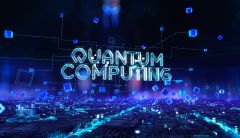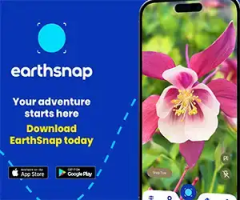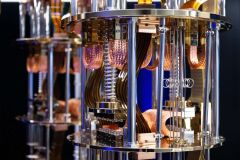Science News

Jan 10th, 2026 - MELBOURNE, Fla. (WFLA) — A Florida zoo welcomed a new species of monkeys on Thursday, which are vulnerable to extinction. The Brevard Zoo announced it is now home to two black-and-white Colobus monkeys. This species of primate is classified ... [Read More]
Source: wfla.com

Jan 10th, 2026 - has been generating a lot of buzz in recent years. The nascent technology could be a way to unlock computing power in a way the world has never seen before, allowing for machines that can handle some unusual and wildly complex types of computations ... [Read More]
Source: fool.com

Jan 10th, 2026 - It's quick and easy to access Live Science Plus, simply enter your email below. We'll send you a confirmation and sign you up for our daily newsletter, keeping you up to date with the latest science news. Facebook X Whatsapp Reddit Flipboard Join ... [Read More]
Source: livescience.com

Jan 10th, 2026 - Follow Earth on Google Dust is everywhere in space. Even the emptiest parts of the universe are full of tiny grains that shape how stars form and how planets eventually come together. For decades, scientists believed this dust needed a decent ... [Read More]
Source: earth.com

Jan 9th, 2026 - As avian flu continues to circulate among wild birds in Massachusetts, a flock of backyard chickens in Dukes County got infected and was euthanized , state health officials said. The chickens "exhibited clinical signs" of Highly Pathogenic Avian Influenza, or HPAI, also known as bird flu, and tested positive for the disease, the state Department of Agricultural Resources said in Jan. 6 a statement. Health officials "safely depopulated and disposed" of the flock, the agency said in a statement. The department did not specify where the birds were located, or if they were a domestic or ... [Read More]
Source: bostonglobe.com

Jan 9th, 2026 - A record-setting wave of bald eagles descended on a small area of northwestern Missouri right before the start of 2026, drawing in visitors from across the region. "We have a new bald eagle record!" Loess Bluffs National Wildlife Refuge said after ... [Read More]
Source: upi.com

Jan 9th, 2026 - Reading time 3 minutes Since its launch in 1990, Hubble has transformed our understanding of the cosmos. The space telescope revealed a universe teeming with galaxies, stars, and planets instead of what we once saw as empty patches of the skies. ... [Read More]
Source: gizmodo.com

Jan 9th, 2026 - Calculations show that injecting randomness into a quantum neural network could help it determine properties of quantum objects that are otherwise fundamentally hard to access The Heisenberg uncertainty principle puts a limit on how precisely we ... [Read More]
Source: newscientist.com

Jan 9th, 2026 - Supermassive black holes are notorious for gobbling up young stars and burping out powerful jets of gas as they finish the snack. Scientists call this mechanism "jet precession." Typically, only two types of jet streams are observed by the ... [Read More]
Source: greenmatters.com

Jan 9th, 2026 - Natu re reinforces the idea that Homo sapiens originated in Africa. This is based on a set of fossils unearthed in a Moroccan cave that date to 773,000 years ago, just around the time when our evolutionary family tree split into what would become Homo sapiens, Neanderthals, and Denisovans. The cave itself, known as Grotte à Hominidés, is located in Casablanca. It looks like it was more of a hangout for predators than a place where early Homo sapiens ever lived. Originally excavated in 1969, it's been an on-again, off-again hub of archaeological digging. CNN reports, Scientists ... [Read More]
Source: vice.com

Jan 9th, 2026 - These Bizarre, Centuries-Old Sharks May Have a Hidden Longevity Superpower Greenland sharks are a biological anomaly. The animals can grow to more than 20 feet long, weigh more than a ton and can live for nearly 400 years , making the species the ... [Read More]
Source: scientificamerican.com

Jan 9th, 2026 - A rescue mission has been launched to save a pod of whales stranded on a remote New Zealand beach . Some 55 pilot whales washed up on Farewell Spit, on the country's southern island on Thursday, with six dying on the shore. Volunteers rushed to the ... [Read More]
Source: aol.com

Jan 9th, 2026 - Earth's ancient nuclear reactors were a freakish natural accident Two billion years before we made history and split the atom, the Earth had already accomplished it and was running its own nuclear reactors. And they operated for hundreds of ... [Read More]
Source: newatlas.com

Jan 9th, 2026 - Follow Earth on Google Cloud-9 sits in a universe that rarely stops shining. Telescopes are built to chase that light and record every spark they can find. Yet some of the most important clues about how the universe works come from places that ... [Read More]
Source: earth.com

Jan 9th, 2026 - Sky This Week is brought to you in part by Celestron. Friday, January 9 Mars is in conjunction with the Sun at 7 A.M. EST, invisible in our sky until mid-March. The bright moon Titan lies near its parent world, Saturn, in the evening sky tonight. The largest of the ringed planet's moons, Titan is the only other solar system world known to host liquid on its surface, though its lakes and seas consist of hydrocarbons (like ethane and methane), not water. The second-largest moon in the solar system after Ganymede, Titan is bigger than the planet Mercury and shines around magnitude ... [Read More]
Source: astronomy.com

Jan 8th, 2026 - By From the ones with tap dancing feet to those that like to go off on adventures, penguins have a special place in popular culture. Though, we don't only love seeing them in animated flicks. We're just as fascinated seeing photos and videos of them in real life, or catching a glance of them at the zoo. Recently, people are amazed at a video of a penguin who looks like they belong in a movie. The @bbcearth TikTok gave audiences a glimpse at a penguin with a rare genetic mutation. It causes this penguin to be a stark white color, and as @bbcearth mentioned in the post caption, this is "one of ... [Read More]
Source: miamiherald.com

Jan 8th, 2026 - Researchers working on China's 'artificial sun' have reported breaking a long-accepted threshold that has limited the operation of nuclear-fusion reactors for decades. China's Experimental Advanced Superconducting Tokamak (EAST) is a nuclear-fusion research reactor in Hefei. Researchers hope that it will one day produce clean, nearly limitless energy by replicating the fusion processes that power the Sun. In fusion reactors, light-weight atoms are compressed under extreme pressure and heat to form heavier atoms. This process releases energy, but it must be optimized carefully so that the ... [Read More]
Source: nature.com

Jan 8th, 2026 - A bipartisan group of United States senators introduced a bill Thursday (Jan. 8) that would extend the National Quantum Initiative (NQI) by five years and expand its activities. The NQI was enacted in 2018 and has supported the U.S. quantum ecosystem, the emergence of dozens of venture-backed quantum startups and the growth of a broader national industry that spans quantum computing, networking and sensing, according to a press release issued Thursday by the Senate Committee on Commerce, Science and Transportation . Quantum computing harnesses the properties of quantum mechanics to perform ... [Read More]
Source: pymnts.com

Jan 8th, 2026 - When a baby smiles at you, it's almost impossible not to smile back. This spontaneous reaction to a facial expression is part of the back-and-forth that allows us to understand each other's emotions and mental states. Faces are so important to social communication that we've evolved specialized brain cells just to recognize them, as Rockefeller University's Winrich Freiwald has discovered. It's just one of a suite of groundbreaking findings the scientist has made in the past decade that have greatly advanced the neuroscience of face perception. Now he and his team in the Laboratory of Neural ... [Read More]
Source: news-medical.net

Jan 8th, 2026 - The updated bill text adds multiple federal hubs to fund workforce growth and quantum technology research and development, as industry leaders hope for swift passage. On Thursday, Sens. Todd Young, R-Ind., and Maria Cantwell, D-Wash., introduced the National Quantum Initiative Reauthorization Act to praise from industry leaders. The National Quantum Initiative Act was initially signed into law by President Donald Trump during his first term in office in 2018. It expired in 2023, and efforts to reauthorize the program have since fallen short of passage. The new legislation would extend the ... [Read More]
Source: nextgov.com